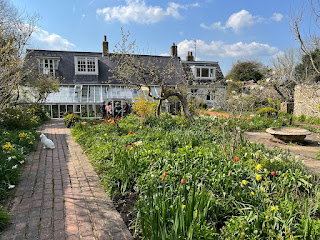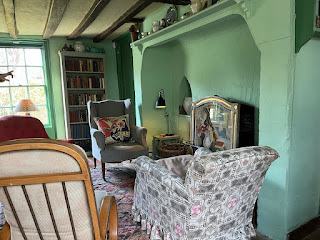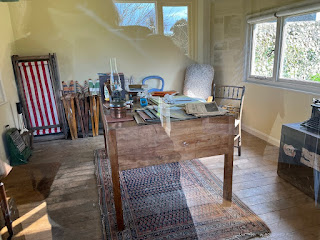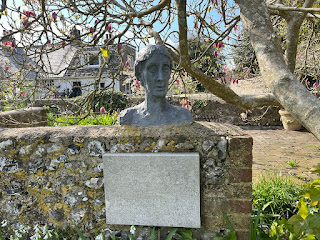If you're a regular National Trust go-er, you'll know that there are loads of different types of NT visitor. There's the Expert Visitor, who likes to correct the tour guides. There's also the lesser-spotted but brilliant Lived-It Visitor, who has some kind of first-hand experience of the place.
But the category of visitor I'd like to talk about today is the Pilgrim Visitor. The Pilgrim is not a casual visitor - they have often travelled a long way to visit a specific NT property for a specific reason. This presents a bit of a challenge to the staff and I'm not sure they always get it quite right - but more on that later.
The properties that tend to attract Pilgrim Visitors are usually connected to a famous person, for example at Greenway (Agatha Christie) or The Firs (Edward Elgar) or the Beatles' Childhood Homes (The Beatles) - I've added a longer list below.
But whichever property they're visiting, you can always spot the Pilgrims by one common identifier: they have a look of ecstatic awed happiness on their faces. It's like they've finally found their ancestral home or caught a glimpse of their hero. They almost start glowing.
Monk's House in East Sussex probably had the most Pilgrims per square foot that I've ever encountered. There are two reasons for this: firstly, Monk's House is very small so it doesn't have many square feet. But the most important reason is that it was once owned by Virginia Woolf and her husband, Leonard.
To give you some idea: I hadn't even made it out of the car park when a group of women in their 20s passed me. They were animatedly debating Virginia Woolf's books, the order in which she had published them, and whether any had been written at Monk's House.
 |
| Rear view of house, with cat probably called Orlando |
And this is where the problem lies. I hate to say it but the visitor experience at Monk's House may need a rethink.
It started well: I booked a ticket online in advance and managed to get there on time. I was expecting some kind of actual tour where a guide collects a group of people and gives them an introductory talk and then either sets them off on their own or actually leads them through the property (like the very excellent Birmingham Back to Backs or Beatles' Childhood Homes).
It turned out that there wasn't a tour at all - and that's fair enough, as they hadn't actually specified there would be one. Instead, I checked in at the reception area, which is very tiny, and was then directed down the street and through a gate. I got to the back door of the property and wasn't really sure what I was supposed to do, so I kept walking and got told off for jumping the queue (and I'm definitely not a queue-jumper so that was a bit awkward).
But the real problems start once you go inside. The property is small, so if more than 5 or 6 people are already looking around a room then you don't really feel able to enter or hang around. But if you're a Pilgrim-type visitor, coming from miles away for an important moment in your favourite writer's house, then you'll want to linger for a while and take it all in. You'll likely have loads of questions. And that's great, because the room guides are really knowledgeable. But when another visitor follows you into that room and catches 5 minutes of your questions, they come out with a really detailed understanding of where the bookcase was found or who made the rug but they'll probably have missed lots of other general information or detail about other things.
One guide during my visit literally said this - she was giving a detailed and very informed answer to a super-specific question and then looked around and said "I've lost track of who's just come in or what you've heard" and it summed up the whole experience for me. It felt like potluck as to whether you learned anything useful, which made it seem disorganised.
When I got home, I read the really good guidebook and immediately wanted to go back. There was so much I'd missed. And that's not completely unusual - on a few previous occasions I've found interesting things in the guidebook that I hadn't appreciated during the visit - but at Monk's House I felt like I'd missed most of it.
 |
| The Sitting Room |
So let me give you a quick summary of the life and times of Monk's House:
- Virginia and Leonard Woolf bought Monk's House as a country retreat in 1919.
- They loved the South Downs - Virginia had previously leased another house in the area with her sister, Vanessa, and when that lease ended she bought Monk's House.
- The house, which had no electricity or running water when they acquired it, is located in the village of Rodmell near Lewes.
- It had been originally built in the late 1600s as a three room cottage for servants. It was then sold on to various families including the Clears, the Glazebrooks, and the Verralls.
- The Woolfs built a two-storey extension in 1930, with one of those rooms becoming Virginia bedroom, which you can visit today.
- The house was decorated by Virginia and filled with artworks by Duncan Grant and other members of the Bloomsbury Group.
- Virginia had originally used an old toolshed in the garden as a place for her writing. In 1934 the couple replaced this with a purpose built writing lodge, which you can see today.
 |
| Virginia Woolf's writing lodge |
- Virginia wrote Mrs Dalloway (1925), To the Lighthouse (1927), Orlando (1928), and The Waves (1931) at Monk's House.
- The couple loved gardening, especially Leonard, and the gardens are still lovely.
- Their London flat was bombed in 1940 and they moved to Rodmell permanently.
- Virginia, who suffered severe bouts of depression, drowned herself in the River Ouse near Monk's House in 1941.
- Leonard Woolf continued to live in Monk's House until his death in 1969. he left the house to his partner, Trekkie Parsons, who offered it to the University of Sussex. The house began to deteriorate and Nigel Nicolson, son of Vita Sackville-West, encouraged the National Trust to take it on and look after it.
I'd been wanting to see Monk's House since I started this project 10 years ago. It's only a few miles from Alfriston Clergy House, which was the first building that the NT ever acquired. However, neither place owns a cafe and until recently I've had to prioritise NT properties with scone opportunities. Now that I've completed all of the scone destinations, I get to visit all the other really fascinating NT places.
In summary, then: if you're a fan of Virginia Woolf, you have to visit Monk's House. It's very easy to imagine her living and working there, making it perfect for any Pilgrim visitor. The visitor experience could admittedly be better, to make it more informative and complete, but the guides are very well informed and there's lots to enjoy in the gardens and local area.
 |
| A walk near to Monk's House |
Monk's House: 4 out of 5
Scone: there's no cafe so no scone and no scone scoring
Other National Trust properties where you're very likely to find Pilgrim Visitors:
- Avebury - popular with fans of Neolithic standing stones
- Bateman's - Rudyard Kipling lived here
- Beatles' Childhood Homes - for obvious reasons
- Carlyle's House - one for fans of Thomas Carlyle
- Chartwell - home of Winston Churchill
- Clouds Hill - used as a place for writing by Lawrence of Arabia
- Coleridge Cottage - Samuel Taylor Coleridge wrote his masterpieces here
- Flatford - childhood home of John Constable
- George Stephenson Birthplace - one for fans of Industrial Revolution geniuses
- Greenway - the summer home of Agatha Christie
- Hadrian's Wall - very famous Roman construction
- Hardy's Cottage - where Thomas Hardy lived and wrote Far From The Madding Crowd
- Hill Top - Lake District home to Beatrix Potter
- Hughenden - home to Benjamin Disraeli
- Leith Hill Place - was once home to Ralph Vaughan Williams
- Max Gate - another Thomas Hardy residence
- Runnymede - where Magna Carta was signed
- Sissinghurst - home and garden of Vita Sackville-West
- Smallhythe Place - Victorian actress Ellen Terry lived here
- Sutton Hoo - one for fans of Anglo-Saxon burial mounds and treasure
- The Firs - childhood home of Edward Elgar
- Washington Old Hall - ancestral home of George Washington
- Wordsworth House - childhood home of William Wordsworth

No comments:
Post a Comment